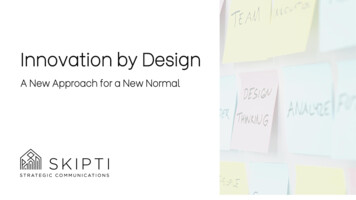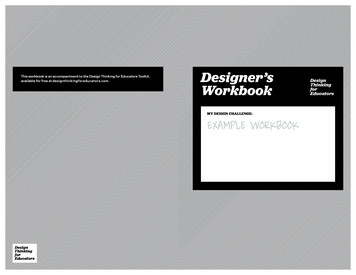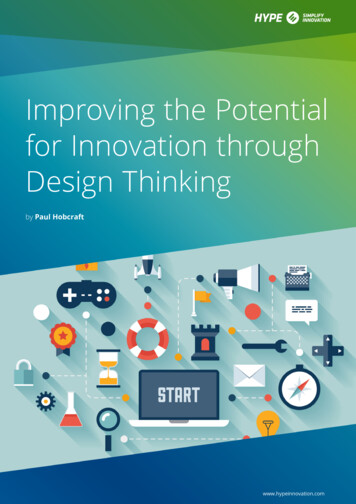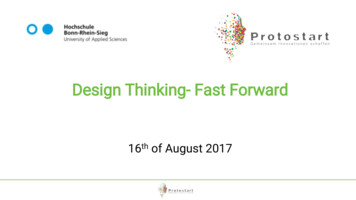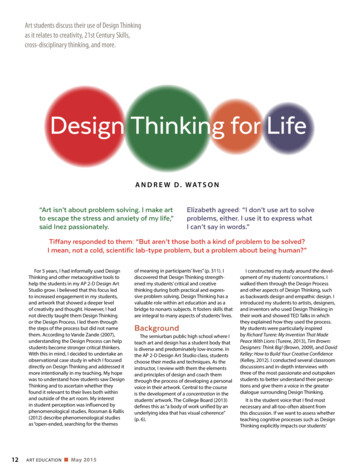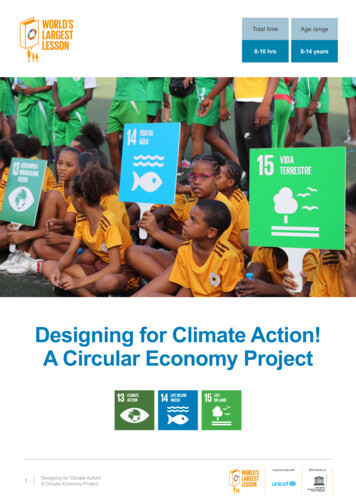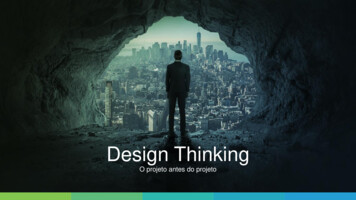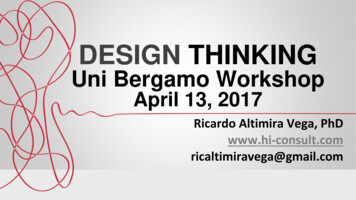
Transcription
DESIGN THINKINGUni Bergamo WorkshopApril 13, 2017Ricardo Altimira Vega, PhDwww.hi-consult.comricaltimiravega@gmail.com
Design thinking:Uni Bergamo Workshop objectives- Familiarize with DT- Share success factors- Exercise one Uni Bergamo case- express- Have Fun
Facilitator: Ricardo Altimira, PhD- PhD Cum Laude-UPM, Spain- Executive MBA, IE B-School, Spain- Master Business and Finance, New York University, USA- President Class, Harvard University, USA- 20 years Associated Professor, IE B-School- Visiting Professor at UTS-Australia / FGVargas-Brazil /SDA Bocconi and Consorzio MIB-Italy / Javeriana-Colombia /Guanghua-Pekin University, China / Tec Monterrey-Mexico- Over 300 Design Thinking workshops in 11 countries- Board Member www.hi-consult.com / www.chefvalo.com
Design thinking: What?Set of tools of designers and architects"transferred" to the world of businessBased on:- Focus on the customer/ user (empathy)- Co-work- Creativity "at its best“:thinking out of the box- Agile and visual prototypes
Design thinking: Where (areas)?- Innovation in products and services- Business models for:- Start-ups- Re-engineering- Digital Transformation for:- Customer/ user- Process- Human team- Problems / Problems / Problems
Design thinking: spaces to “create”- Hubs- Creativity Centers- Iconic Buildings
Impact-Hub Madrid
U-lab / UTS – Sydney
Hub AREA 31 – IE B-SCHOOL, Madrid
Guggenheim Museum-Bilbao /Deusto B-School
Design thinking: Who is Who?(Invitation to read / e-visit / site-visit)- Tim Brown ( IDEO / USA)- David Kelley ( Stanford D-School / USA)- Roger Martin ( Harvard B-School / USA)- Frank Ghery (FOGA / USA)
Design thinking: Who is who?Tim Brown (IDEO)David Kelley (Stanford D-School)
Design thinking:Who is who?Roger Martin (Harvard)Frank Ghery (FOGA)
Design thinking: How?5 I’s methodologySources: Stanford-IDEO / HPI / UTS- Identification- Invitation- Ideation- Iteration- Implementation
DESIGN THINKING: How?The 5 I s methodology2.InviteThose stakeholderswhose talent andexperience can bringvalue and creativity1.IDENTIFYObserve andempathizewith clients and usersto understandtheir point of viewabout the problem.5.IMPLEMENTIncluding measures ofsuccess and impact4.ITERATEThrough rapidand economicprototypeswith stakeholdersand and Divergent6 .
Design thinking “express” exercise:Proposed challengesIdentification step-I1.2.3.4.Individual work: Post-ItTeam work: Discussion with leadersPair of teams agreementPresentations
Design thinking “express” exercise:Proposed challengesIdentification step-I: post-its/posters.
Design thinking “express” exercise:Proposed challengesIdentification step-I: post-its/posters.
Design thinking “express” exercise:Proposed challengesIdentification step-I: post-its/posters.
Design thinking “express” exercise:Proposed challengesIdentification step-I: post-its/posters.
Design thinking “express” exercise:Proposed challengesIdentification step - II(Summary prepared by each teamleader and agreed with teamleader from neighbour table).
Design thinking Uni Bergamo “express”Proposed challenges - Summary
Design thinking “express” exercise:Ideation step (Third “I”)(We decided that an App for thestudents will be the solution for thecvhallenges and we brainstorm thefunctionality of the App).
Design thinking “express” exercise:Ideation step (Third “I”).
Design Tools Building Blocks( DT tools assignment by teams)
Design thinking “express” exercise:Building Blocks for DT ToolsCo-working Teams-Up.
Design Propthinking “express” exercise:Building Blocks(Co-work Tables)
Design thinking “express” exercise:Building Blocks (Co-work Tables)
Design thinking “express” exercise:Building Blocks (Co-work Tables)
Design Tools Building Blocks( DT tools - “elevator pitch” contest)Customer Journey
Design Tools Building Blocks( DT tools - “elevator pitch” contest)Empathy Map
Design Tools Building Blocks( DT tools - “elevator pitch” contest)Stakeholders Canvas
Design Tools Building Blocks( DT tools - “elevator pitch” contest)Business Model Canvas( www.businessmodelcanvas.com)
Conclusions:- Great Job on our “express” exercise!- Design thinking is here to stay and to help UniBergamo students--Thanks for your participationand always at your disposal:ricaltimiravega@gmail.com
Design thinking: Who is who? Tim Brown (IDEO) David Kelley (Stanford D-School) Design thinking:Who is who? Roger Martin (Harvard) Frank Ghery (FOGA) Design thinking: How? 5 I’s methodology Sources: Stanford-IDEO / HPI / UTS - Identification - Invitation - Ideatio


